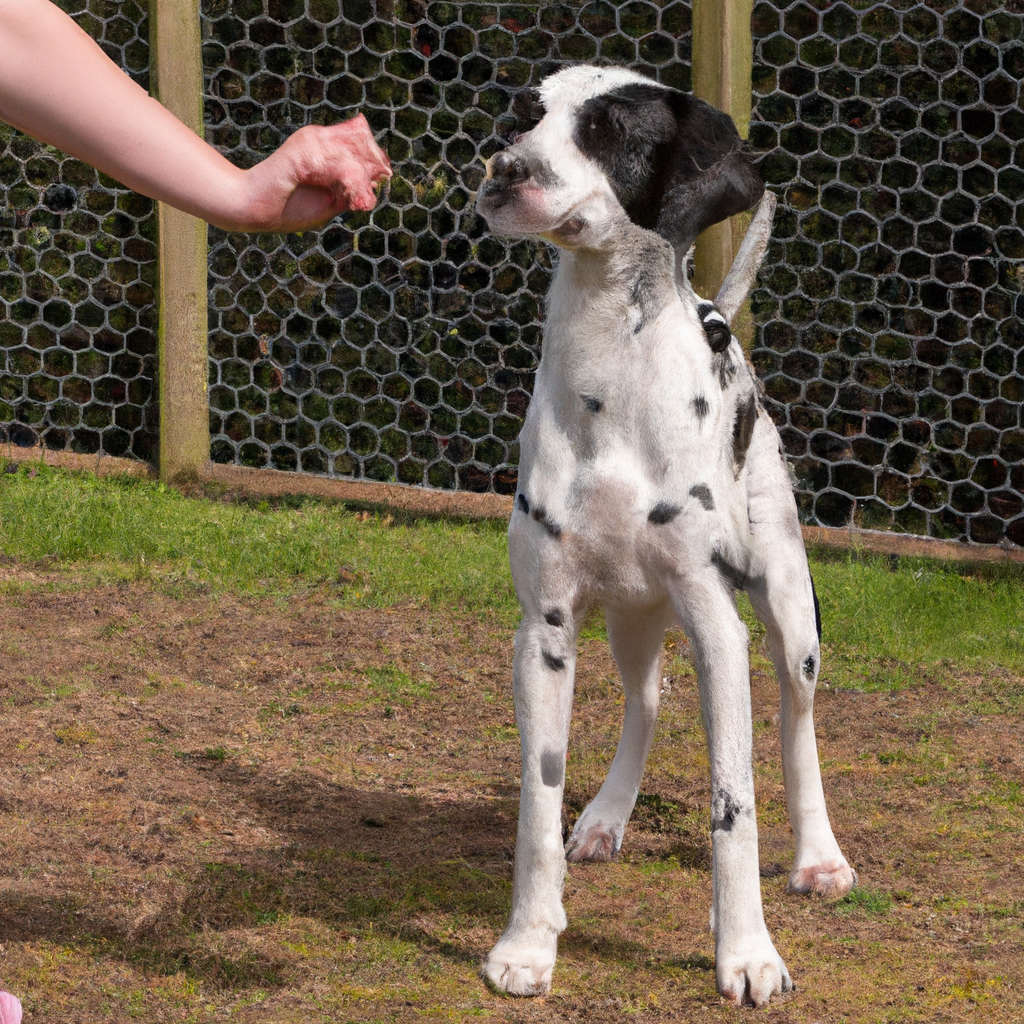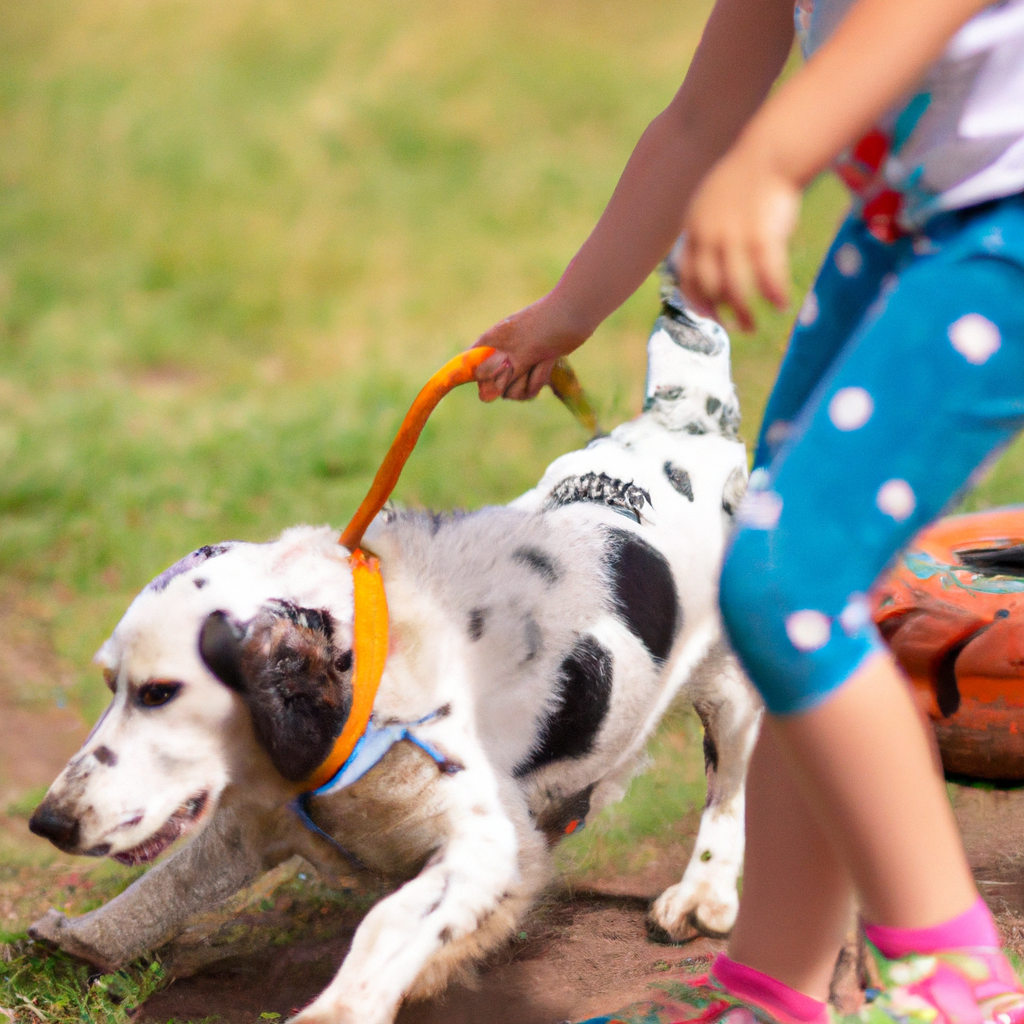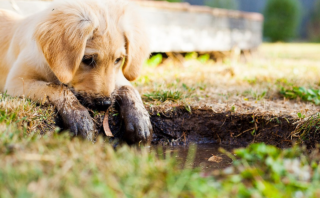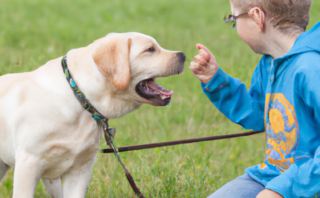<div class="wp-block-embedwrapper”>
Introduction
Training a dog can be a fun activity that also helps children develop skills such as patience, kindness, and responsibility. This guide will introduce kids to the basics of dog training, fostering a stronger bond between them and their furry buddies. Step-by-step methods and tips will ensure a fun and rewarding experience.

It’s time to enthuse young minds about the world of canine language and discipline.
Definition of Dog Training
Dog Training is a systematic process of teaching, conditioning and reinforcing desirable habits in dogs. It includes obedience exercises, behavior modification, and other tasks to establish good discipline. Training is fundamental in shaping a dog’s behavior for safety, socialization, and cooperative living. It involves techniques such as reward-based training, clicker training, and positive reinforcement, creating a reliable, obedient, and contented canine companion.
Importance of Dog Training for Kids
Dog training introduces kids to the virtues of responsibility, empathy, and commitment. It aids their cognitive development and boosts self-esteem, forming rich bonds of friendship with their pets. Misunderstandings between dogs and kids can lead to potential mishaps. Hence, training plays a significant role ensuring safety and fostering love. It’s a priceless lesson that fosters depth and nuance in the child’s understanding of respect, care and emotional bonding.
Overview of the Article Sections
This article unfolds in several enriching sections. ###Understanding the Dog’s Language unveils insights into canine language. ###Essential Training Commands presents basic directives children can learn. ###Training Techniques offers practical guidance on how to train effectively, while ###Making Training a Fun Activity suggests ways to amuse both the child and the dog. In our final section, ###Guard Against Mistreatment, we reassess our responsibilities towards our furry friends.
Section 1: Understanding Dogs
Before embarking on dog training, it’s crucial for kids to grasp what makes dogs unique. Dogs are not humans, despite the temptation to think so. Their thinking and emotional patterns differ. It’s essential to understand their language, and learn to read their body signals. In doing so we not only foster a safe environment, but also we respect their canine nature. This empathetic approach is the foundation of effective dog training.
Basic Canine Communication
Understanding canine communication is fundamental for a successful interaction with dogs. Dogs primarily communicate through body language—it’s their way of ‘talking’. The position of their tail, ears, mouth, and body can reveal a lot about their feelings. A wagging tail generally indicates happiness, whereas a lowered tail suggests discomfort. Recognizing these signs can avoid misunderstandings and lay the foundation for a strong bond between a child and their furry friend.
How Dogs Learn
Understanding canines’ learning behavior is vital for effective training. Dogs learn through repeated experiences. They associate stimuli with consequences, a phenomenon known as Pavlovian conditioning. The stimuli can be actions like sitting or fetching. If a dog’s action results in a positive experience like getting a treat, they are more likely to repeat that behavior. A vital part of training dogs involves replicating these positive experiences to encourage desirable behaviors.
Dog Behaviors
Understanding a dog’s behavior is the groundwork for effective training. Dogs communicate through vocalization, body language, and facial expressions. Recognizing these signals could prevent accidents and proficiently improve dog-human interaction. Ponding a dog’s tail often symbolizes happiness and snarling likely signals aggression. Signs of stress can include whimpering and yawning. Understanding these behaviors is crucial for kids to have a safe and enjoyable experience with their furry friends.
Section 2: The Role of a Dog in a Child's Life
A dog isn’t just a pet; it’s a lifetime companion which positively influences a child’s growth. Enhancing empathy, responsibility, and socialization, dogs aid in children’s emotional development. They can also provide comfort and unconditional love. Since caring for a pet requires commitment, children learn dedication and the importance of caretaking. Finally, training a dog poses a fun and educational opportunity, nurturing a child’s problem-solving skills, boosting their confidence and fostering resilience.
Companionship
Training a dog instills a sense of responsibility in kids, but notably, it also nurtures companionship. Through training, children learn to communicate with their furry friends, helping to build trust and mutual respect. This shared experience strengthens their bond, turning a pet dog into a lifelong friend. Consequently, it’s not just about teaching commands; dog training presents an opportunity for children to understand the essence of friendship and companionship.
Development of Responsibility
Dog training provides a unique opportunity for kids to develop responsibility. Day-to-day activities such as feeding, grooming and walking require the child to take on pet-related duties diligently. Children learn to consider their pet’s needs above their own at times, teach them important skills such as pain management and discipline, and instill in them a sense of accountability and duty. Consequently, this fosters maturity and duty-consciousness in children.
Health and Wellness Benefits
Training dogs can be immensely beneficial for a child’s health and wellness. Beyond the obvious physical activity promoting fitness, it supports mental well-being by fostering patience, empathy, and responsibility. Hand-eye coordination develops while executing commands. Furthermore, studies suggest lowered blood pressure and reduced anxiety due to pets’ continual companionship. Lastly, the sense of accomplishment derived from training a dog can significantly boost a child’s self-esteem.
Section 3: Setting Ground Rules for Dog Training
Setting ground rules for dog training involves clear communication of expectations and consistency. The foremost rule is treating your dog gently and kindly. Tailor commands to be short, specific, and constant. Rewards for good behavior, like treats or praise, reinforce positive actions. Remember, consistency is key; fluctuating rules may confuse the dog. Lastly, children involved in training must exercise patience, because, a well-trained dog is not an overnight miracle.
Importance of Consistency in Training
Consistency in dog training is fundamental, especially for children. It entails sticking to specific commands and behaviors to avoid confusing the dog. By maintaining a clear, consistent routine, kids can effectively teach their dogs to understand what is expected of them. Important elements include: consistent timing, tone, rewards, and consequences. A lack of consistency can cause uncertainty, leading to issues with obedience and overall training efficacy.
Rules for Safe Interaction
Understanding how to safely engage with dogs is pivotal for kids. Firstly, never approach an unfamiliar dog without the owner’s permission. Secondly, avoid direct eye contact and sudden movements. Thirdly, do not disturb dogs while they’re eating, sleeping, or caring for puppies. Also, remember to approach from the side, not frontally. Treat them with kindness and respect. Following these guidelines will facilitate a better understanding and safer interaction with dogs.
Discipline Without Force
Training a dog doesn’t need force. Instead, teaching with patience and positive reinforcement is beneficial. Reward your dog’s good behaviors with treats, praises, or toys. Ignore or correct bad behaviors calmly, without physical punishment. This method nurtures a trusting relationship, ensuring your dog sees you as a leader, not a threat. Remember, yelling or harsh punishments can make your dog fearful or aggressive, undoing progress made. Effective discipline is kind, respectful, and force-free.
Section 4: Age-Appropriate Dog Training Techniques for Kids
Training a dog can be exciting for kids, but it’s necessary to employ age-appropriate techniques. Young children should begin with simple commands such as ‘sit’ and ‘fetch’. Teenagers can master more complex instructions like ‘heel’ and ‘stay’. Always ensure safety is paramount; never leave a child alone to train a large or feisty dog. Initiating kids into dog-training responsibly can foster a beautiful bond between human and animal. Remember, patience is key.
For Toddlers and Preschoolers
Engaging toddlers and preschoolers in dog training can be both educational and fun. Start with teaching the basic commands such as “sit” or “stay”. Introduce interactive games like fetch, which enhance the dog-child bond as well as teach the fundamentals of obedience. Always emphasize respect and gentleness towards the pet. Remember, supervision from adults is essential to ensure the safety for both the child and the dog.
For School-age Children
At the school-age, children can take an active part in dog training. Called upon to reinforce commands and positive behavior, they augur well as integral members in training routines. Basic commands like ‘sit’, ‘stay’ and ‘come’ can be effectively relayed by kids, which fosters mutual respect and forms a strong bond. It also teaches responsibility, empathy, and caring. However, supervision by an adult is advisable to ensure the safety of both the child and the dog.
For Teenagers
For teenagers, dog training can be an exercise in responsibility, discipline, and empathy. Understanding a dog’s needs and teaching it to respond to commands can build teens’ communication and leadership skills. Initiating fun-filled training sessions, with rewards for the dog, can make this an exciting task. A trained dog is not just a pet but a companion, and this process can also strengthen the emotional bond between a teenager and their pet.
Section 5: Basic Dog Training Commands Kids Can Teach
Children can play essential roles in dog training.

Simple commands such as “Sit”, “Stay”, and “Come” can easily be learned at a young age. Active involvement enhances bonding between children and their pets, while teaching responsibility. Start with basic commands, then gradually progress to more complex ones. Always remember, patience and consistency are vital for successful training. Let your child become a junior dog trainer today!
Sit
Teaching your dog to ‘Sit’ is an essential part of basic training. Start by holding a treat close to the dog’s nose and slowly lift it upwards, causing the dog to sit back. As soon as your dog adopts this posture, say ‘Sit’ and give the treat. Repeat this process frequently until the dog begins to sit on command without prompting. This command helps divert your dog’s attention in potentially distracting situations.
Stay
Training your dog to stay is an essential part of obedience. The process may be challenging but with practice, it becomes easy. Start by using a leash as a tool to control movements. Give the command ‘Stay’ and if your dog obeys, reward with a treat. If they move, restart the exercise. Over time, increase the duration of the ‘Stay’. This helps your dog learn patience and also ensures their safety in different situations.
Come
When training your pet, the ‘Come’ command is essential for safety and control. Start training by putting a leash on your dog, then step back and call their name followed by the word ‘come’. If they obey, reward them with a treat or praise. Practice in various settings and gradually increase the distance. Remember, patience and consistency are key in training. Soon, your dog will respond to this command even without a leash.
Leave it/Drop it
Teaching your dog the “leave it” or “drop it” command can prevent harmful ingestion. Begin training with an object the dog enjoys. When your pet shows interest, firmly say “leave it.” Reward free will drop with a treat. Start with short distances then gradually extend. For kids, the key is repetition and patience. This command ensures safety during playtime, essentially making it an indispensable element of responsible dog ownership and training.
Section 6: Making Dog Training a Fun Activity
Training your dog should never feel like a chore. Incorporate games and rewards, making the process enjoyable for both you and your furry friend. Treats, affection, and praise can stimulate your dog to learn quickly while having fun. Try hide and seek or fetch to improve their ability to follow commands. Remember, positivity and patience are crucial. Remember, making dog training a delightful activity ensures a stronger bond between you and your pet.
Incorporating Games in Training
Teaching your child to train their dog can be an enriching experience. Incorporating games into the training process makes it enjoyable and fruitful. Start with simple games, like fetch or hide-and-seek, which stimulate the dog’s cognitive abilities. Then, gradually introduce games that involve commands, like ‘sit’, ‘stay’ or ‘come’. This fun method not only strengthens the bond between child and pet, but also effectively instills obedience in the dog.
Involving the Dog in Daily Routines
Including the family dog in daily routines is beneficial, promoting teamwork and empathy in children. Kids can contribute to their pet’s care by feeding, cleaning, or taking the dog out for a daily walk. This activity can create a strong bond between the child and the dog, helping the child develop a sense of responsibility. Remember, every interaction is a mini-lesson – make sure they treat their dogs kindly and respectfully.
Reward System in Dog Training
An integral part of any dog training process is the reward system. It’s a powerful technique that reinforces good behavior. You reward your dog with a treat, a toy, or attention after they’ve followed a command. This encourages positive behavior, helping the dog understand what’s expected, and creates a bond between trainer and dog. For kids, it’s essential to understand this principle to effectively train their dogs.
Section 7: Dealing with Potential Training Challenges
When training dogs, children may encounter a few hurdles. Obstacles like lack of focus or stubbornness in dogs can be discouraging. To overcome these, introduce training as fun games to capture the dog’s interest. Patience is key. Reinforce behavior with rewards. If a dog repeatedly fails to follow a command, simplify it. Remember, each dog has a different learning pace. Above all, kids should always treat dogs with love and respect.
Unresponsiveness to Commands
At times, dogs can be unresponsive to commands. This can stem from a lack of understanding or distractions in the environment. Teaching kids about patience, consistency, and timing is crucial. Be consistent with commands and deliver them in a clear, firm voice for the dog to recognize. Reward successful obedience, helping establish a positive association. An Unresponsiveness to commands can be a testing phase, testing your patience and training techniques.
Aggression or Fear
Understanding your dog’s emotions is crucial. Many behaviors perceived as aggression are often fear-based. A fearful dog may growl, snap, or bite when it feels cornered or threatened. Kids should be taught to observe these signs and keep a respectful distance. It’s essential to reassure the dog in these situations to curb any aggressive tendencies. Always remember, most dogs don’t bite out of malice, but in response to a perceived threat.
Distraction or Overexcitement
Overexcitement or distraction can impede your kid’s progress during dog training. Puppies, notably, are easily distracted and can become hyperactive. To overcome this, maintain a calm environment, eliminating potential distractions. Use short, engaging training sessions to keep the dog’s attention. Gradually introduce new stimuli as your dog masters each task. Remember, patience and consistency are key in managing overexcited or easily distracted puppies in the dog training process for kids.
Section 8: Benefits of Professional Dog Training Assistance
Professional dog training assistance provides several benefits. First, it ensures the use of effective training methods and promotes the dog’s optimal behavior. Second, it aids kids in understanding their pets better, fostering a stronger bond. Third, it cultivates discipline and respect in the child–dog relationship. Lastly, professional guidance reduces risks of unintentional harsh handling or misinterpretation of the dog’s actions, fostering a safer and healthier environment for both.
When to Seek Professional Help
Sometimes, despite your best efforts, you may hit a roadblock in training your dog. Perhaps your furry friend is struggling with a specific command or is showing aggressive behavior. In such instances, it’s important to seek professional help early to prevent further complications. Expert dog trainers possess the expertise to troubleshoot these issues and provide a tailored approach that meets the unique needs of your dog.
What to Expect From a Professional Dog Trainer
A professional dog trainer teaches your pet obedience and commands, starting from simple tasks to advanced training. They help correct behavioral issues, enhancing your pet’s social skills, and improving your dog’s overall discipline. The trainer’s methods involve positive reinforcement, creating an engaging environment for your pet. Added benefits could also include expert advice on nutrition and health care, providing a holistic approach to dog training.
Finding a Good Dog Trainer
Finding a good dog trainer isn’t as daunting as it may sound. It requires methodical research. First, look for professionals with certification from recognized dog-training institutions. Next, observe a training session to assess their techniques. Lastly, ensure they can work well with kids, as a trainer’s ability to teach children can enhance the overall experience. A solid dog trainer collaborative, patient, and knowledgeable about how various dog breeds learn.
Conclusion
In conclusion, dog training isn’t just beneficial for pets, but also for kids. It nurtures responsibility, empathy, and companionship while teaching invaluable life skills. As tough as it may seem, the outcomes far outweigh the efforts invested. Remember, consistency, positive reinforcement, and patience are the keys in making this a fruitful engagement. It’s about bonding, understanding and growth for both the pet and your child, making it a rewarding experience.
Recap of Key Points
Dog training for kids encourages empathy, responsibility, and critical thinking. Understanding canine body language helps kids interpret dog behavior and prevent mishaps. Teaching commands requires patience and constancy, nurturing resilience. Praise-reinforced training promotes positive reinforcement principles. Incorporating safe playtime fosters a healthy dog-kid relationship. Regular training sessions foster a routine, teaching time-management. Ultimately, dog training for kids not only nurtures a well-behaved pet, but well-rounded children too.
Importance of Patience and Persistence in Dog Training
Dog training requires patience and persistence. Hasty training can lead to frustration for you and your pet. Persistent and patient efforts, however, yield better results. Patience allows time for understanding and learning, while persistent training reinforces lessons. Remember, every dog has a unique personality and learning curve. Positive reinforcement, consistency, and a calm demeanor form an ideal training environment. Successful training nurtures a rewarding bond between you and your dog.
Final thoughts and encouragement
Training a dog can be tough for kids, yet immensely rewarding. The bond strengthened is unparalleled. Perseverance is crucial – remember, consistency is key. Celebrate every tiny success, practice patience, and persist. With a positive outlook, you’ll see fantastic progress. We’re cheering for you – keep up the great work!
Frequently Asked Questions
1. What is the appropriate age for kids to start dog training?
While the specific age can vary, generally, children around the age of six or seven are mature enough to participate in dog training activities. However, the dog’s temperament and the child’s maturity level also play a significant factor. It’s important to remember that an adult should always supervise these activities to ensure safety for both the child and the dog.
2. What kind of tasks can kids handle in dog training?
Kids can handle various tasks depending on their age and maturity level. Younger children can help with simple tasks such as feeding or playing fetch, while older children can engage in more complex training activities like teaching the dog to sit, stay, or roll over. It’s crucial that the tasks assigned to children are age-appropriate and that they are comfortable with them.
3. How can dog training benefit kids?
Dog training can have numerous benefits for children. It can teach them responsibility, empathy, patience, and improve their self-esteem. Moreover, it can also help them understand the importance of consistency and discipline. Additionally, it can strengthen the bond between the child and the dog, making their relationship more enjoyable and fulfilling.
4. What are some safety precautions kids should take during dog training?
Children should always be supervised by an adult during dog training sessions. They should be taught to respect the dog’s personal space and to not tease or provoke the dog. It’s also essential for them to learn how to interpret a dog’s body language to prevent any potential accidents. Children should also be instructed to wash their hands before and after the training session.
5. What type of dogs are best for kids to train?
The best type of dogs for kids to train are generally those that are known for their friendly, patient, and obedient nature. Breeds like Golden Retrievers, Labrador Retrievers, Beagles, and Boxers are often recommended. However, the individual temperament of the dog is also an important factor. It’s always a good idea to spend some time with the dog before deciding if it’s a good fit for your child and family.
6. What should I do if my child is afraid of training the dog?
If your child is afraid of training the dog, it’s essential to be patient and understanding. Start by letting your child observe the dog from a safe distance. Gradually, as they become more comfortable, encourage them to participate in simple, non-threatening activities such as feeding the dog or playing fetch. Over time, this can help reduce their fear and build their confidence.
7. How can I make dog training fun for my kids?
Make the training sessions a game and offer lots of praise and rewards not just for the dog, but also for your child. You can also involve your child in dog training classes if they are available in your area. These classes are often designed to be fun and engaging, which can make the experience more enjoyable for your child.
Conclusion
In conclusion, dog training for kids can be an enriching and educational experience that teaches children about responsibility, empathy, and the importance of clear communication. It’s not only beneficial for the children but also for the dogs, as they learn to interact positively with young ones and respond to their commands. Moreover, through this process, a deep bond of companionship and trust is built between the child and the dog, which can be a source of immense joy and comfort for both.
The key to successful dog training for kids is to ensure it is age-appropriate, fun, and safe. It is essential that children are taught to respect the dog’s boundaries and understand their cues. The use of positive reinforcement techniques is highly encouraged as it promotes a healthy and positive relationship between the child and the dog. In the end, dog training for kids can be a fun-filled, educational journey that results in a well-behaved pet and a more responsible, caring child.


